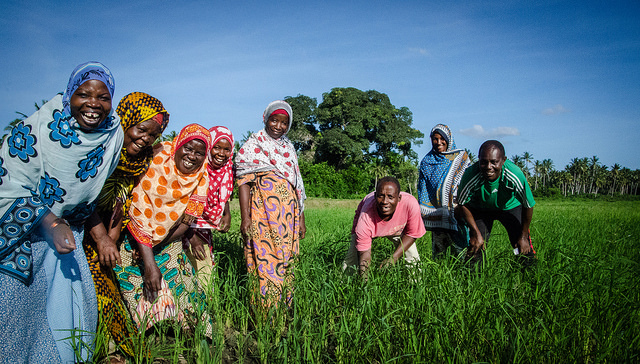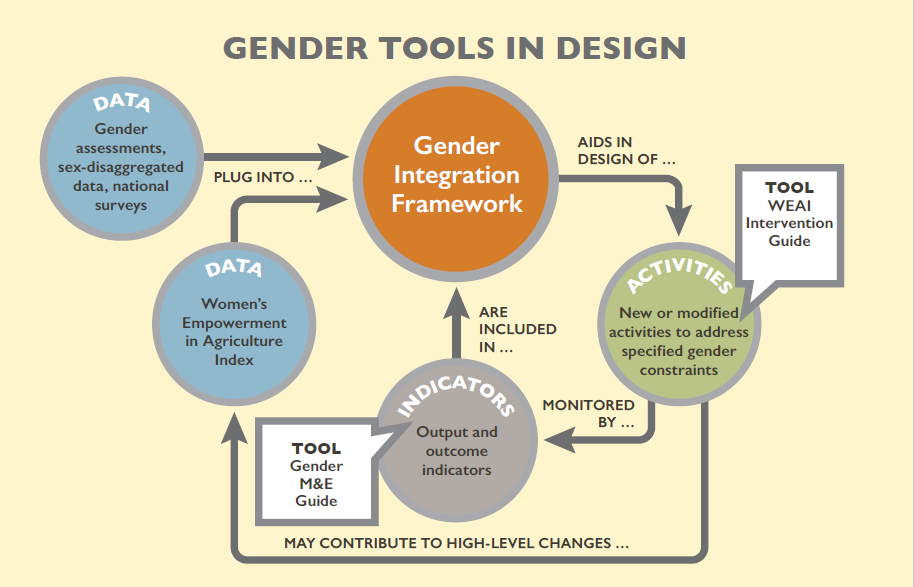Gettin’ GIF-fy With It: Using the WEAI and GIF to Mainstream Gender in Your Work
This blog post was cross-posted from Agrilinks.
Have you heard of the Women’s Empowerment in Agriculture Index (more commonly referred to as the WEAI)? I’m sure many of you have not only heard of it, but have used it in your work: In 2015 alone, 13 Feed the Future partners used WEAI data to inform programming, and to date, close to 40 organizations worldwide are using the WEAI, increasing the evidence-base on constraints women and men face in the agriculture sector. Some of you may also be familiar with the Gender Integration Framework, or GIF—a useful tool for integrating gender into project design and implementation.

Tanzanian farmers with increased rice yields after planting improved seeds.
What you might not know is just how to use the WEAI and GIF together. What is the relationship between the two, and how can both tools be used to promote gender mainstreaming? How does their use help us work toward our objectives of increased agricultural productivity and improved nutritional outcomes? To that end, Agrilinks hosted a pilot training on the WEAI and GIF to help USAID staff better understand each tool and how they work together. But if you weren’t at the training, here’s our rundown.
First things first—let’s talk about data. The WEAI is a survey tool used to gather data on different domains of empowerment, which are each comprised of one to three weighted indicators. Applying the WEAI survey gets you a WEAI score, composed of two parts:
- The five domains of empowerment (5DE) score measures how empowered women are across five domains—production, resources, income, leadership and time—and makes up 90 percent of the overall WEAI score.
- The other 10 percent of the WEAI score is derived from the Gender Parity Index (GPI), which measures the gap in empowerment between the main male decision-maker and main female decision-maker in the same household.
Now, the WEAI data should be used in conjunction with other country and context-specific data—national surveys and statistics, gender assessments, and the like. All of these data sources should help paint a pretty good picture of what the largest constraints are to women’s empowerment (in agriculture) in a country. This is where the GIF comes in. The highest-priority constraints are identified using the GIF by “plugging in” the different data sources and ranking the domains. The GIF is then used by missions and projects to design new activities to address these constraints (for example, to improve women's control over income), or to modify existing activities to better address the identified barriers to women’s empowerment. So really, the GIF can help you create a strategic plan, hold your project accountable, and monitor and evaluate outcomes through the use of your indicators. Hopefully, the next iteration of data collection may even reflect some high-level changes to women’s empowerment in agriculture as a result!
So, there you have it. I’m going to leave you with a great graphic that depicts this relationship even more clearly:
Now that the pilot is complete, Agrilinks will host a number of other regional trainings to help USAID Mission staff learn about these tools, starting with a training in Bangkok from March 7-10. For those of you looking for more WEAI and GIF resources otherwise, check out these links:
- A WEAI webinar, the Baseline Report, and more can be found here.
- Check out our team’s recent blog post covering different adaptations and usages of the WEAI.
- Fleur Wouterse, a Research Fellow at IFPRI, recently dug into WEAI data in Niger.
- Take a listen to this webinar on the GIF and check out the matrix and other useful resources on this page.
- Wondering how to translate into practice the evidence and insights gained from the WEAI survey tool? We'd like to point you to the WEAI Intervention Guide.
Let us know how you’ve used the WEAI or GIF in your work! What are you trouble-shooting? Do you have a success (or failure!) worth sharing? Use the comments section below to post your questions or thoughts.



